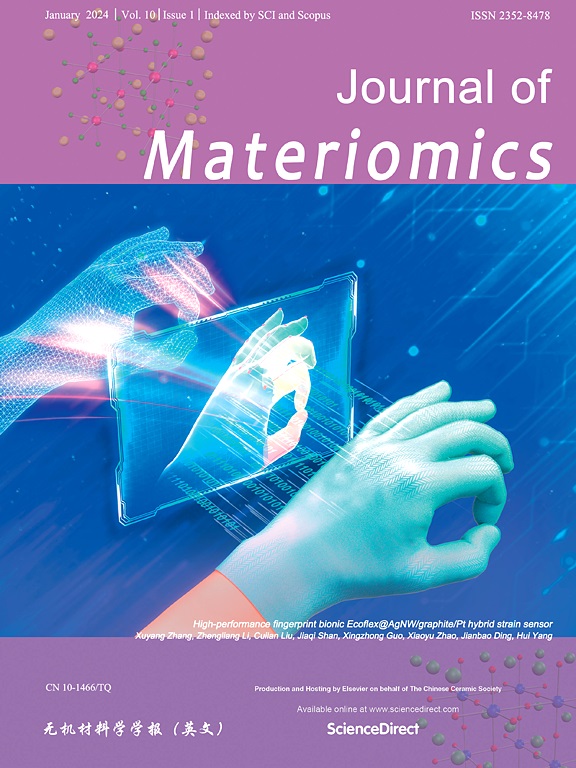Development of n-type Ti2CoNiSb2 double half-Heusler compound by the breaking of valence-balanced rule and achieving high thermoelectric performance via Bi/Cu co-doping
IF 9.6
1区 材料科学
Q1 CHEMISTRY, PHYSICAL
引用次数: 0
Abstract
Half-Heusler (HH) thermoelectric materials exhibit excellent electronic transport properties but suffer from intrinsically high lattice thermal conductivity, which limits their thermoelectric performance. To address this challenge, double half-Heusler (DHH) compounds with 18 valence electrons have recently been proposed. However, the disordered nature of DHH phases often degrades their electronic transport properties, hindering the achievement of high thermoelectric conversion efficiency. In this work, we design a new n-type Ti2CoNiSb2 DHH compound with 18.5 valence electrons by combining TiCoSb and TiNiSb half-Heuslers, intentionally breaking the conventional valence balance. Furthermore, the effects of Cu and Bi doping at the Ni and Sb sites, respectively, are systematically investigated. Cu doping effectively enhances phonon scattering through point defects, while Bi doping significantly improves the weighted mobility. When Cu and Bi are co-doped, phonon scattering is further strengthened, particularly at high temperatures, and the weighted mobility is simultaneously increased. As a result, a peak figure of merit (zT) of ∼0.82 is achieved at 973 K in Ti2CoNi0.9Cu0.1(Sb0.925Bi0.075)2, nearly four times higher than that of the pristine Ti2CoNiSb2 (zT ∼0.22). This work highlights the effectiveness of co-doping strategies that simultaneously optimize thermal and electronic transport properties in DHH thermoelectric systems.


打破价平衡规律,通过Bi/Cu共掺杂制备n型Ti2CoNiSb2双半heusler化合物,获得高热电性能
半赫斯勒(HH)热电材料具有优异的电子输运性能,但其固有的高晶格导热系数限制了其热电性能。为了解决这一挑战,最近提出了具有18个价电子的双半赫斯勒(DHH)化合物。然而,DHH相的无序性往往会降低其电子输运性质,阻碍了高热电转换效率的实现。在这项工作中,我们设计了一个新的n型Ti2CoNiSb2 DHH化合物,通过将TiCoSb和TiNiSb半heuslers结合,有意打破传统的价平衡,具有18.5个价电子。此外,系统地研究了Cu和Bi分别在Ni和Sb位点掺杂的影响。Cu掺杂有效地增强了声子通过点缺陷的散射,Bi掺杂则显著提高了加权迁移率。当Cu和Bi共掺杂时,声子散射进一步增强,特别是在高温下,加权迁移率同时提高。结果,在973 K时,Ti2CoNi0.9Cu0.1(Sb0.925Bi0.075)2的峰值品质值(zT)达到了~ 0.82,几乎是原始Ti2CoNiSb2 (zT ~ 0.22)的四倍。这项工作强调了在DHH热电系统中同时优化热输运和电子输运特性的共掺杂策略的有效性。
本文章由计算机程序翻译,如有差异,请以英文原文为准。
求助全文
约1分钟内获得全文
求助全文
来源期刊

Journal of Materiomics
Materials Science-Metals and Alloys
CiteScore
14.30
自引率
6.40%
发文量
331
审稿时长
37 days
期刊介绍:
The Journal of Materiomics is a peer-reviewed open-access journal that aims to serve as a forum for the continuous dissemination of research within the field of materials science. It particularly emphasizes systematic studies on the relationships between composition, processing, structure, property, and performance of advanced materials. The journal is supported by the Chinese Ceramic Society and is indexed in SCIE and Scopus. It is commonly referred to as J Materiomics.
 求助内容:
求助内容: 应助结果提醒方式:
应助结果提醒方式:


